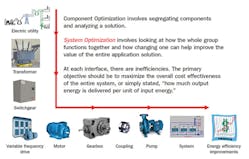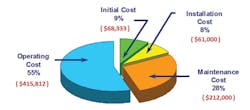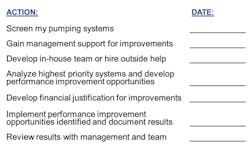Pumping systems typically account for a significant portion of a facility’s energy use. Some industries have higher pump loads than others. For some plants, pumps are the largest end-using system for electricity. For example, commercial buildings include pumps as part of heating, cooling, water heating, wastewater and refrigeration systems. These pump-based systems consume more than 35 percent of a commercial building’s energy.
Figure 1 shows the energy levels associated with different industries and equipment. While pumping systems across all industrial sectors represent the highest energy users, they also represent the greatest potential to save energy and reduce maintenance-related expenses.
Factors contributing to pump inefficiency
A 1996 report from the Finnish Technical Research Center titled Expert Systems for Diagnosis and Performance of Centrifugal Pumps indicated that average pump system operating efficiency was below 40 percent and that more than 10 percent of pump systems operated below 10 percent efficiency. Results are based on the analysis of 1,690 pumps at 20 process plants. Exceptions apply for small pumps and pumps of low specific speed, but most industrial pumps should be able to achieve 70 to 85 percent efficiency. Three main factors contribute to pumps operating at reduced efficiency:
-
- The pump system includes the pump, driver, piping, controls and power distribution. When making pump improvements, many times focus is placed on upgrading individual components and not the entire system. However, component failures are often caused by system interaction problems. While installing more efficient parts — such as motors — makes small improvements, the whole pump system must be considered relative to the normal operating points to achieve optimal efficiency levels. Improving a single pump’s efficiency and not focusing on the system interaction will do little to reduce energy usage. During system optimization, one must look at how all components work together and how changing one can help improve the value of the entire application solution.
- No standards exist to guide efficient pumping system design. Because engineering contractors and owners/operators can choose how to size the system components and controls, designs are unchallenged. Owners and operators may not be aware of the energy impacts when the lowest initial-cost solution that meets the rated conditions is presented without consideration of energy efficiency. Without a standard, liability does not exist for poorly designed and inefficient pumping systems. As a result, owners/operators are ultimately responsible for energy consumption and maintenance.
- Organizations purchase pump systems based on price instead of the total life cycle systems costs. However, lifetime energy costs can be 40 times the installed cost of a pumping system. Figure 3 outlines the factors that contribute to the 20-year life cycle cost of a standard 75-horsepower pumping system. Initial costs are minimal in comparison to ongoing operating and maintenance costs over a span of two decades.
The need for pump system optimization
When not optimized for best efficiency, pump systems drain profits. According to the U.S. Industrial Motor Systems Market Opportunities Assessment, an average medium-sized plant spends more than $1,400,000 per year on energy to run its pumping systems. In most pumping systems, the energy added to the working fluid by the pump is much greater than what is required by the process. Oversized piping system components such as pumps, process subassemblies and control valves often cause that excess energy usage (see Figure 4). When excess energy is added to the pumping system, control elements absorb it throughout the system, adding heat, noise and vibration to control components, reducing their operating life and adding to system maintenance costs. As pumps worldwide consume nearly 20 percent of global motor energy, opportunities exist across all industries for energy and cost savings through pump optimization.
New regulations from the United States Department of Energy require companies to take a closer look at pump system efficiency. By January 2020, manufacturers must comply with minimum pump standards outlined in the recently published regulation at 10 CFR 431 Subpart Y. Compliance with the regulation is solely the responsibility of the pump manufacturer, but the owners of pumping systems should become familiar with the new Pump Energy Index rating that will be labeled on regulated pumps by January of 2020. Prior to January 2020 and after pumps become regulated, pump owners can take advantage of the currently available voluntary industry labeling program that utilizes the HI Energy Rating Label (pumps.org/40.5) as a tool in their pump selections and systems optimization.
What systems should be optimized?
System optimization is the process of identifying, understanding and cost-effectively eliminating unnecessary losses while reducing energy consumption and improving reliability in pumping systems.
Since most industrial and municipal plants have tens, hundreds and even thousands of pumping systems, assessments are necessary to identify and quantify opportunities for reducing pump system energy consumption as well as improving pump reliability and process control. Energy savings of 20 to 40 percent are typically achievable after implementing the recommendations made through a formal pump system assessment.
Figure 5 outlines a pump system assessment action plan that can help structure tasks.
The first step of an assessment includes screening pumps for improvement. Candidates can include large or problematic pumps such as those with high operating hours, cavitation noise, excessive vibration, frequent on/off cycling and higher-than-average maintenance costs. Pumping systems with one or more of these symptoms are ideal for further assessment. Large, high-maintenance systems that are mission-critical to the process or facility operation are top priorities.
Management must be kept in the loop during assessments by sharing documentation on best candidates. Internal support is also necessary to conduct thorough pump assessments. An in-house assessment team should include personnel from production, operations, maintenance, finance and management. If in-house skills do not exist, a specialist can fill any voids.
Pumps identified during the screening process go through a more thorough assessment or analysis to confirm performance opportunities. A life cycle cost (LCC) analysis can develop financial justification for improvements by relating pumping system improvements to economics. An LCC analysis can assess the cost of purchasing, installing, operating, maintaining and disposing of the system’s components. When documenting anticipated cost savings, include local utility rebates or incentives.
Once approved, implement performance improvement solutions and document the positive impact of solutions. Measure the actual results against anticipated gains. Develop written management reports, listing system improvements, cost savings and other benefits. Gain approval for continuing the action plan process for other good candidates.
It is important to follow the plan and create a partnership among production, purchasing and management. Find out what they consider important and begin with a small project. Always document activities and findings, measuring and reporting the impact of system changes in terms meaningful to management and production.
Because pump system optimization should not be a one-time effort, companies must embed ongoing assessments into the maintenance, operational and management culture of pump-intensive industries. The Hydraulic Institute offers an online Pump Systems Assessment Certificate course that teaches the essential processes, steps and proven methodologies to manage and conduct complex pumping systems audits and identify high-value optimization opportunities in industrial or commercial applications.
As the savings potential associated with optimizing pumping systems generally far exceeds other cost-savings approaches, pump owners and operators should understand the general concepts of a pump system assessment and the value it can bring.
Mark Sullivan serves as director of education and marketing within the Pump Systems Matter organization, a subsidiary of the Hydraulic Institute, which develops engineering fluid transfer standards for diverse industrial and commercial markets with operations headquartered in Parsippany, New Jersey. He has nearly four decades of industrial marketing experience in nonprofit and for-profit organizations including Fortune 100 corporations and educational institutions. Sullivan has earned a national reputation in implementing ROI-driven integrated and sustainable strategic programs supporting long-term revenue growth. In his four years at the Hydraulic Institute, he has grown technical education and training by more than 120 percent.






